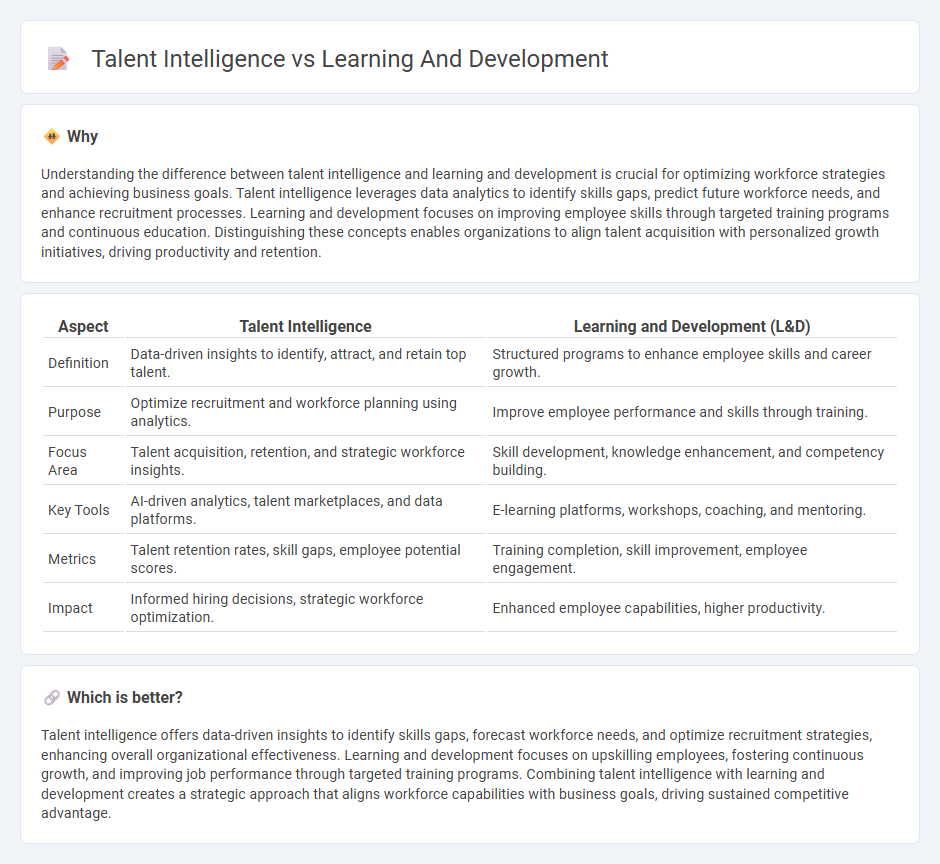
Talent intelligence leverages data analytics and AI to identify skill gaps, predict workforce trends, and optimize recruitment strategies, driving smarter hiring decisions. Learning and development focuses on enhancing employee skills through targeted training programs and continuous education to improve performance and career growth. Explore how integrating talent intelligence with learning and development can transform your organization's workforce strategy.
Why it is important
Understanding the difference between talent intelligence and learning and development is crucial for optimizing workforce strategies and achieving business goals. Talent intelligence leverages data analytics to identify skills gaps, predict future workforce needs, and enhance recruitment processes. Learning and development focuses on improving employee skills through targeted training programs and continuous education. Distinguishing these concepts enables organizations to align talent acquisition with personalized growth initiatives, driving productivity and retention.
Comparison Table
| Aspect | Talent Intelligence | Learning and Development (L&D) |
|---|---|---|
| Definition | Data-driven insights to identify, attract, and retain top talent. | Structured programs to enhance employee skills and career growth. |
| Purpose | Optimize recruitment and workforce planning using analytics. | Improve employee performance and skills through training. |
| Focus Area | Talent acquisition, retention, and strategic workforce insights. | Skill development, knowledge enhancement, and competency building. |
| Key Tools | AI-driven analytics, talent marketplaces, and data platforms. | E-learning platforms, workshops, coaching, and mentoring. |
| Metrics | Talent retention rates, skill gaps, employee potential scores. | Training completion, skill improvement, employee engagement. |
| Impact | Informed hiring decisions, strategic workforce optimization. | Enhanced employee capabilities, higher productivity. |
Which is better?
Talent intelligence offers data-driven insights to identify skills gaps, forecast workforce needs, and optimize recruitment strategies, enhancing overall organizational effectiveness. Learning and development focuses on upskilling employees, fostering continuous growth, and improving job performance through targeted training programs. Combining talent intelligence with learning and development creates a strategic approach that aligns workforce capabilities with business goals, driving sustained competitive advantage.
Connection
Talent intelligence enhances workforce strategies by providing data-driven insights that identify skill gaps and future talent needs, directly informing targeted learning and development programs. Learning and development initiatives leverage these insights to tailor training modules that boost employee competencies and align with organizational goals. Integrating talent intelligence with learning and development accelerates skill acquisition, improves employee performance, and supports strategic workforce planning.
Key Terms
**Learning and Development:**
Learning and Development (L&D) prioritizes employee skill enhancement through structured training programs, fostering continuous professional growth and improved performance. It leverages data-driven methodologies to tailor personalized learning paths aligned with organizational goals and workforce competencies. Discover how integrating advanced L&D strategies can transform talent capabilities and drive business success.
Training Programs
Learning and development emphasizes structured training programs to enhance employee skills and drive organizational growth. Talent intelligence leverages data analytics to identify skill gaps and tailor training initiatives for higher impact. Discover how integrating both approaches can revolutionize your training programs.
Skills Assessment
Learning and development programs prioritize skills assessment to identify gaps and tailor training initiatives that enhance employee competencies. Talent intelligence leverages data analytics to evaluate workforce capabilities, predict future skill needs, and optimize talent acquisition strategies. Explore how integrating skills assessment with talent intelligence transforms organizational growth and performance.
Source and External Links
Learning and Development: A Comprehensive Guide - Learning and development (L&D) is a systematic process to enhance employees' skills, knowledge, and competency, improving work performance and playing a key role in talent attraction, retention, company culture, and employee engagement.
L&D: What Is Learning and Development? - Learning and development helps companies retain and attract skilled talent, improve company culture, and engage employees, offering programs like onboarding, on-the-job training, mentorship, and formal training.
Learning and Development Importance [Updated 2025] - Learning and development aligns employee goals with organizational objectives by identifying skill gaps, developing strategies, delivering training, and utilizing technology for better ROI and company performance.
 dowidth.com
dowidth.com